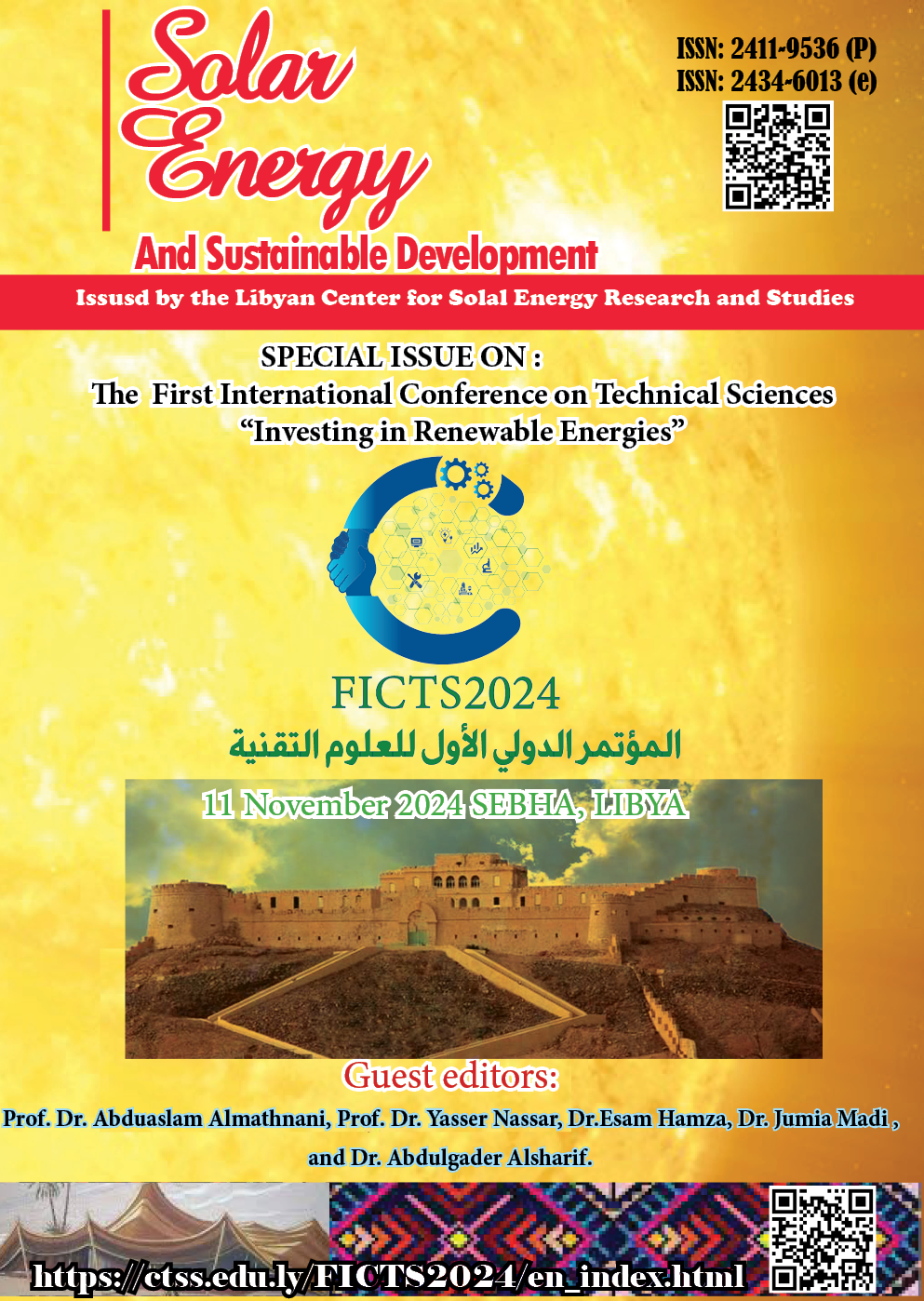Enhance Photovoltaic/Thermal (PV/T) System Performance by Using Nanofluid
DOI:
https://doi.org/10.51646/jsesd.v14iFICTS-2024.441Keywords:
Coolant, Efficiency, Nanofluid, CFD, Photovoltaic cell.Abstract
High temperatures significantly degrade the performance of photovoltaic (PV) panels, particularly in hot regions. To mitigate this issue, hybrid PV/thermal systems have emerged, combining PV panels with thermal collectors. These systems utilize a cooling fluid to remove excess heat from the PV panels, improving their efficiency and enabling the recovery of thermal energy. This study investigates the potential of nanofluids as a superior cooling medium for hybrid PV/thermal systems. Nanofluids, engineered suspensions of nanoparticles in base fluids, offer enhanced thermal properties compared to conventional fluids. A numerical analysis using the finite volume method (FVM) based on Ansys software / CFD fluent was conducted to simulate the performance of a hybrid PV/thermal system under hot weather conditions. The study focused on natural convection cooling, eliminating the need for pumps and reducing energy consumption. Results indicate that decreasing the inlet velocity of the nanofluid significantly reduced the surface temperature of the PV panels. A reduction in inlet velocity to 0.0001 m/s led to a 4.5 K decrease in surface temperature, while a velocity of 0.00005 m/s resulted in a 6 K decrease. Conversely, the temperature of the nanofluid outlet increased by 16 K and 30 K for the respective velocities, signifying enhanced heat extraction. These findings demonstrate that optimizing the flow rate of the nanofluid can significantly improve the electrical and thermal performance of hybrid PV/thermal systems. This research contributes to the development of more efficient and sustainable solar energy technologies.
Downloads
Metrics
References
AHMED, Md Tofael, et al. Classification and Parametric Analysis of Solar Hybrid PVT System: A Review. Energies, 2024, 17.3: 588. DOI: https://doi.org/10.3390/en17030588
JIAO, Yue; XING, Meibo; ESTELLÉ, Patrice. Efficient utilization of hybrid photovoltaic/thermal solar systems by nanofluid-based spectral beam splitting: A review. Solar Energy Materials and Solar Cells, 2024, 265: 112648. DOI: https://doi.org/10.1016/j.solmat.2023.112648
NASSAR, F., et al. Thermoelectrical analysis of a new hybrid PV-thermal flat plate solar collector. In: 2023 8th International Engineering Conference on Renewable Energy & Sustainability (ieCRES). IEEE, 2023. p. 1-5. DOI: https://doi.org/10.1109/ieCRES57315.2023.10209472
PRASETYO, Singgih Dwi, et al. Optimization of Photovoltaic Thermal Collectors Using Fins: A Review of Strategies for Enhanced Solar Energy Harvesting. Mathematical Modelling of Engineering Problems, 2023, 10.4. DOI: https://doi.org/10.18280/mmep.100416
KOZAK-JAGIEŁA, Ewa; CISEK, Piotr; OCŁOŃ, Paweł. Cooling techniques for PV panels: A review. Sci. Radices, 2023, 2: 47-68. DOI: https://doi.org/10.58332/scirad2023v2i1a03
ETAIG, Saleh; HASHEM, Gamal. Numerical Investigation on the Laminar Flow in a Vertical Pipe with Elliptic Cross Section. International Journal of Science and Research (IJSR), 2020, 9: 1588-1592.
ABDELRAZIK, Ahmed S., et al. A review on recent development for the design and packaging of hybrid photovoltaic/thermal (PV/T) solar systems. Renewable and Sustainable Energy Reviews, 2018, 95: 110-129. DOI: https://doi.org/10.1016/j.rser.2018.07.013
HASANUZZAMAN, M., et al. Energy savings and emissions reductions for rewinding and replacement of industrial motor. Energy, 2011, 36.1: 233-240. DOI: https://doi.org/10.1016/j.energy.2010.10.046
ELLABBAN, Omar; ABU-RUB, Haitham; BLAABJERG, Frede. Renewable energy resources: Current status, future prospects and their enabling technology. Renewable and sustainable energy reviews, 2014, 39: 748-764. DOI: https://doi.org/10.1016/j.rser.2014.07.113
ETAIG, Saleh, et al. Investigation of the Heat Performance for Hyper Nanofluid in a Co-Current Shell and Tube Heat Exchanger. International Journal of Engineering Research & Technology (IJERT), 2019, 8.12. DOI: https://doi.org/10.17577/IJERTV8IS120063
ROGER, M.; JERRY, V. Photovoltaic Systems Engineering. Vasa. 2005.
OZTURK, Murat; DINCER, Ibrahim. Thermodynamic analysis of a solar-based multi-generation system with hydrogen production. Applied Thermal Engineering, 2013, 51.1-2: 1235-1244. DOI: https://doi.org/10.1016/j.applthermaleng.2012.11.042
POPOVICI, Cătălin George, et al. Efficiency improvement of photovoltaic panels by using air cooled heat sinks. Energy procedia, 2016, 85: 425-432. DOI: https://doi.org/10.1016/j.egypro.2015.12.223
ETAIG, Saleh; HASHEM, Gamal. Numerical Investigation on the Laminar Flow in a Vertical Pipe with Elliptic Cross Section. International Journal of Science and Research (IJSR), 2020, 9: 1588-1592.
NASRIN, Rehena; ALIM, M. A. Thermal performance of nanofluid filled solar flat plate collector. International Journal of Heat and Technology, 2015, 33.2: 17-24. DOI: https://doi.org/10.18280/ijht.330203
HASSANI, Samir, et al. A cascade nanofluid-based PV/T system with optimized optical and thermal properties. Energy, 2016, 112: 963-975. DOI: https://doi.org/10.1016/j.energy.2016.06.142
ZAMZAMIAN, Amirhossein, et al. An experimental study on the effect of Cu-synthesized/EG nanofluid on the efficiency of flat-plate solar collectors. Renewable Energy, 2014, 71: 658-664. DOI: https://doi.org/10.1016/j.renene.2014.06.003
AN, Wei, et al. Investigation on a spectral splitting photovoltaic/thermal hybrid system based on polypyrrole nanofluid: preliminary test. Renewable energy, 2016, 86: 633-642. DOI: https://doi.org/10.1016/j.renene.2015.08.080
AL-WAELI, Ali HA, et al. Evaluation of the nanofluid and nano-PCM based photovoltaic thermal (PVT) system: An experimental study. Energy Conversion and Management, 2017, 151: 693-708. DOI: https://doi.org/10.1016/j.enconman.2017.09.032
AL-SHAMANI, Ali Najah, et al. Experimental studies of rectangular tube absorber photovoltaic thermal collector with various types of nanofluids under the tropical climate conditions. Energy Conversion and Management, 2016, 124: 528-542. DOI: https://doi.org/10.1016/j.enconman.2016.07.052
KALOGIROU, Soteris A., et al. Exergy analysis on solar thermal systems: a better understanding of their sustainability. Renewable Energy, 2016, 85: 1328-1333. DOI: https://doi.org/10.1016/j.renene.2015.05.037
XU, Zelin; KLEINSTREUER, Clement. Concentration photovoltaic–thermal energy co-generation system using nanofluids for cooling and heating. Energy conversion and management, 2014, 87: 504-512. DOI: https://doi.org/10.1016/j.enconman.2014.07.047
GANGADEVI, R.; AGARWAL, Shobhit; ROY, Shirsho. A novel hybrid solar system using nanofluid. Int J Eng Res Technol, 2013, 6.6: 747-752.
GHADIRI, Matin, et al. Experimental investigation of a PVT system performance using nano ferrofluids. Energy Conversion and Management, 2015, 103: 468-476. DOI: https://doi.org/10.1016/j.enconman.2015.06.077
SARDARABADI, Mohammad; PASSANDIDEH-FARD, Mohammad. Experimental and numerical study of metal-oxides/water nanofluids as coolant in photovoltaic thermal systems (PVT). Solar Energy Materials and Solar Cells, 2016, 157: 533-542. DOI: https://doi.org/10.1016/j.solmat.2016.07.008
SARDARABADI, Mohammad; PASSANDIDEH-FARD, Mohammad; HERIS, Saeed Zeinali. Experimental investigation of the effects of silica/water nanofluid on PV/T (photovoltaic thermal units). Energy, 2014, 66: 264-272. DOI: https://doi.org/10.1016/j.energy.2014.01.102
ETAIG, Saleh; HASAN, Reaz; PERERA, Noel. Investigation of enhancement of heat transfer in natural convection utilizing of nanofluids. International Journal of Mechanical and Mechatronics Engineering, 2015, 9.2: 390-395.
CREGAN, V.; MYERS, T. G. Modelling the efficiency of a nanofluid direct absorption solar collector. International Journal of Heat and Mass Transfer, 2015, 90: 505-514. DOI: https://doi.org/10.1016/j.ijheatmasstransfer.2015.06.055
SAHOTA, Lovedeep, et al. Analytical characteristic equation of nanofluid loaded active double slope solar still coupled with helically coiled heat exchanger. Energy Conversion and Management, 2017, 135: 308-326. DOI: https://doi.org/10.1016/j.enconman.2016.12.078
AZMI, W. H., et al. Influence of certain thermo-physical properties on prandtl number of water based nanofluids. In: National conference in mechanical engineering research and post-graduate students, UMP, Kuantan, Pahang, Malaysia. 2010. p. 26-27.
LARI, Muhammad O.; SAHIN, Ahmet Z. Effect of retrofitting a silver/water nanofluid-based photovoltaic/thermal (PV/T) system with a PCM-thermal battery for residential applications. Renewable Energy, 2018, 122: 98-107. DOI: https://doi.org/10.1016/j.renene.2018.01.034
YU, W.; CHOI, and SUS. The role of interfacial layers in the enhanced thermal conductivity of nanofluids: a renovated Maxwell model. Journal of nanoparticle research, 2003, 5: 167-171. DOI: https://doi.org/10.1023/A:1024438603801
PAK, Bock Choon; CHO, Young I. Hydrodynamic and heat transfer study of dispersed fluids with submicron metallic oxide particles. Experimental Heat Transfer an International Journal, 1998, 11.2: 151-170. DOI: https://doi.org/10.1080/08916159808946559
SOMMERS, Andrew D.; YERKES, Kirk L. Experimental investigation into the convective heat transfer and system-level effects of Al 2 O 3-propanol nanofluid. Journal of Nanoparticle Research, 2010, 12: 1003-1014. DOI: https://doi.org/10.1007/s11051-009-9657-3
ETAIG, Saleh; HASAN, Reaz; PERERA, Noel. Investigation of the Flow Characteristics of Titanium-Oxide-Water Nanofluid in Microchannel with Circular Cross Section. American Journal of Nano Research and Applications, 2017, 5.6: 102-109. DOI: https://doi.org/10.11648/j.nano.20170506.14
BANISI, S.; FINCH, J. A.; LAPLANTE, A. R. Electrical conductivity of dispersions: A review. Minerals engineering, 1993, 6.4: 369-385. DOI: https://doi.org/10.1016/0892-6875(93)90016-G
JOSHI, A. S., et al. Performance evaluation of a hybrid photovoltaic thermal (PV/T)(glass-to-glass) system. International Journal of Thermal Sciences, 2009, 48.1: 154-164. DOI: https://doi.org/10.1016/j.ijthermalsci.2008.05.001
SKOPLAKI, Elisa; PALYVOS, John A. On the temperature dependence of photovoltaic module electrical performance: A review of efficiency/power correlations. Solar energy, 2009, 83.5: 614-624. DOI: https://doi.org/10.1016/j.solener.2008.10.008
TEO, H. G.; LEE, P. S.; HAWLADER, M. N. A. An active cooling system for photovoltaic modules. applied energy, 2012, 90.1: 309-315. DOI: https://doi.org/10.1016/j.apenergy.2011.01.017
MCADAMS, William Henry; MCADAMS, William H. Heat transmission. New York: McGraw-hill, 1954.
DUBEY, Swapnil; TAY, Andrew AO. Testing of two different types of photovoltaic–thermal (PVT) modules with heat flow pattern under tropical climatic conditions. Energy for Sustainable Development, 2013, 17.1: 1-12. DOI: https://doi.org/10.1016/j.esd.2012.09.001
TIWARI, Arvind; SODHA, M. S. Performance evaluation of hybrid PV/thermal water/air heating system: a parametric study. Renewable energy, 2006, 31.15: 2460-2474. DOI: https://doi.org/10.1016/j.renene.2005.12.002
KRAUTER, Stefan. Solar electric power generation. Springer Berlin Heidelberg, Berlin, Heidelberg. doi, 2006, 10: 978-3.
KAYS, William Morrow; CRAWFORD, Michael E.; WEIGAND, Bernhard. Convective heat and mass transfer. New York: McGraw-Hill, 1980.
NAHAR, Afroza; HASANUZZAMAN, M.; RAHIM, N. A. Numerical and experimental investigation on the performance of a photovoltaic thermal collector with parallel plate flow channel under different operating conditions in Malaysia. Solar Energy, 2017, 144: 517-528. DOI: https://doi.org/10.1016/j.solener.2017.01.041
ETAIG, Saleh. Investigation of the enhancement of convective heat transfer for wall-bounded flows utilizing nanofluids. University of Northumbria at Newcastle (United Kingdom), 2017.
HAMOUDAH, Khalid Salih; ETAIG, Saleh. Numerical Investigation of PV/T System Cooling Using Nanofluids. African Journal of Advanced Pure and Applied Sciences (AJAPAS), 2024, 543-554.
SETYOHANDOKO, Gabriel, et al. A numerical approach to study the performance of photovoltaic panels by using aluminium heat sink. Journal of Advanced Research in Fluid Mechanics and Thermal Sciences, 2020, 70.2: 97-105. DOI: https://doi.org/10.37934/arfmts.70.2.97105
NASSAR, Yasser, et al. Optimum number of glass covers of thermal flat plate solar collectors. Wadi Alshatti University Journal of Pure and Applied Sciences, 2024, 2.1: 1-10.
NASSAR, Fathi; SALEM, Abubaker Awidat. The reliability of the photovoltaic utilization in southern cities of Libya. Desalination, 2007, 209.1-3: 86-90. DOI: https://doi.org/10.1016/j.desal.2007.04.013
HAMOUDAH, Khalid; ETAIG, Saleh; ELABEEDY, Esam A. Comprehensive Study of The Impact of Water and Nanofluid Cooling on the Performance of Hybrid Photovoltaic Panels at Varied Irradiation Values. In: Sebha University Conference Proceedings. 2024. p. 252-258.
NASSAR, Y.; SALEM, A.; SERGIEVSKY, E. A creation of mathematical model for photovoltaic/thermal (PV/T) solar flat-plate collector. In: International conference on renewable energy for regional development CIGA, Bogor–Indonesia. 2001. p. 28-31.
NASSAR, F., et al. Design of an isolated renewable hybrid energy system: a case study. Materials for Renewable and Sustainable Energy, 2022, 11.3: 225-240. DOI: https://doi.org/10.1007/s40243-022-00216-1
ALDALI, Yasser, et al. Validation of Thermal Models for Polycrystalline Photovoltaic Module Under Derna City Climate Conditions. Solar Energy and Sustainable Development Journal, 2018, 7.2: 27-40. DOI: https://doi.org/10.51646/jsesd.v7i2.39
Downloads
Published
How to Cite
Issue
Section
License
Copyright (c) 2025 Solar Energy and Sustainable Development Journal

This work is licensed under a Creative Commons Attribution-NonCommercial 4.0 International License.














